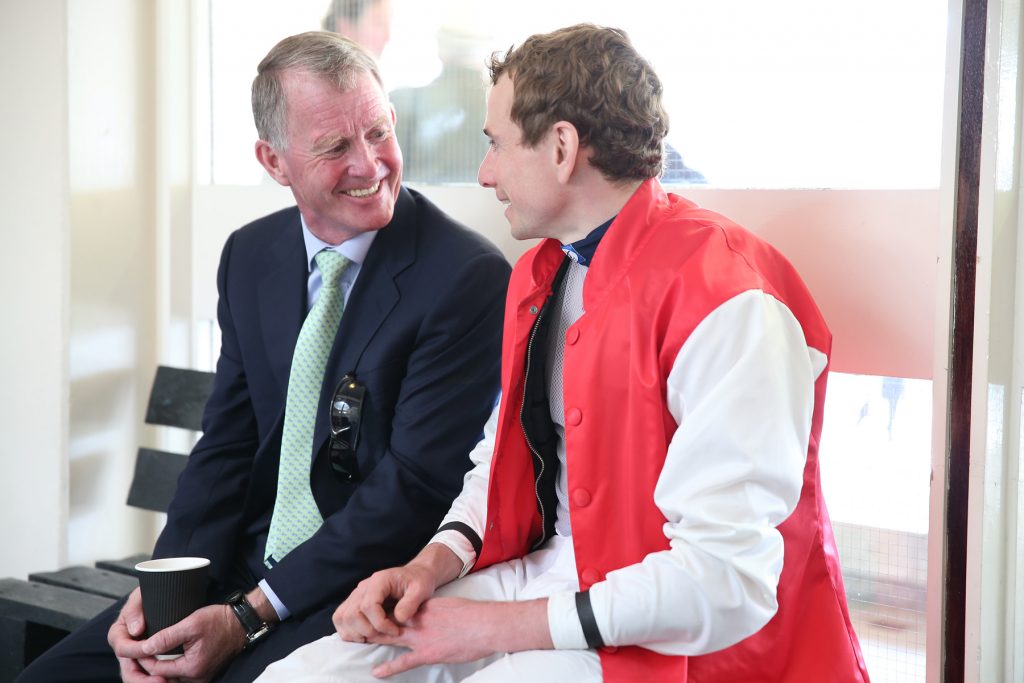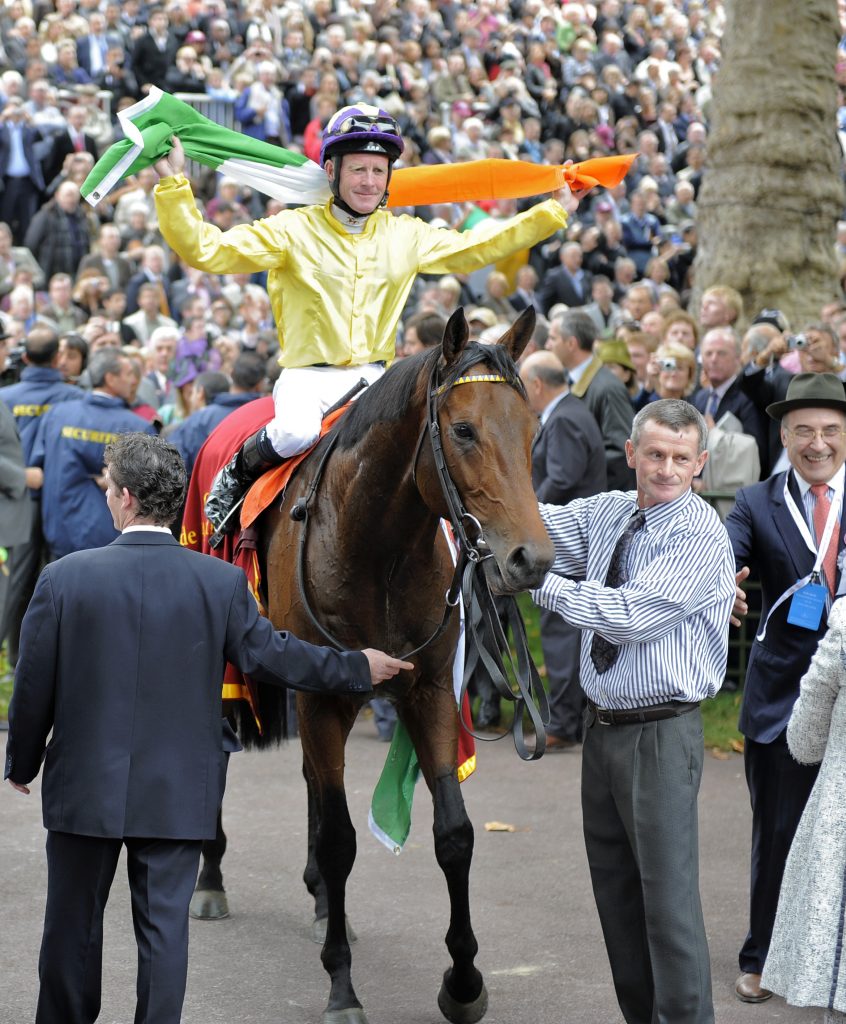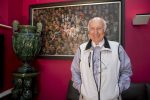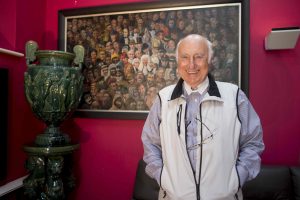The fruits of a rewarding career are plainly evident as you approach tall gates guarding the entrance to an immaculately kept property. Once inside, post and rail flank the drive towards a white-washed house surrounded by paddocks.
It is a spacious structure, yet unostentatious in the mould of its owner. And when the front door opens you are welcomed by a man radiating contentment. Six years on from calling time in the saddle, Mick Kinane looks every inch the riding icon in blissful retirement.
Truth be told, however, first impressions can deceive. There is nothing whatsoever contrived about Kinane’s countenance, it’s just that it took him a while to find it. After one year of gratefully winding down, shedding his body of adrenaline’s caustic byproducts, he struggled in year two.
This huge mental adjustment dragged him into a vacuum which he recognised but had never previously experienced. He had seen it in others; seen how recently retired jockeys found the transition bewildering to the point where some had self-destructed.
Just as he overcame professional turbulence by staying grounded, Kinane came to terms with bewilderment. You’d have backed him to do that, just as you’d have backed him with your last £10 to bring home the final-race favourite. But the gravity of his tone underlines that this was one of the hardest races he was ever asked to win.
“Life is a different pace when you’re not chasing around but it takes a while to adjust to it,” he reflects. “The first year was a novelty; you do things you always wanted, but suddenly going from flat out to full stop is not easy.”
This isn’t readily appreciated by people when they see retired jockeys on the racecourse. It seems like their natural habitat, after all, but the context suddenly flips on its head.
Life is a different pace when you’re not chasing around but it takes a while to adjust to it
“I had to learn to become a racegoer,” Kinane continues. “That was a push. I still wanted to go, to be involved, because I’d seen too many jockeys just disappear. But it’s a completely different environment. You’re still thinking at the same speed but you’re on the outside looking in. And suddenly you have to become sociable.
“You know, most of us jockeys left school very young. We knew nothing else. It’s a very limited education, so unless you’re fortunate enough to be able to buy a property or have some revenue coming in, you have to start all over again.
“Jockeys are adrenaline junkies, pure and simple. It’s a big buzz riding a 500kg horse at 40 miles an hour when you’re stacked up. There’s no margin for error. It’s hard to get that kick from anything else.”

Kinane with Ryan Moore
It is fascinating to hear Kinane talk insightfully about such issues. He was a man of few words in his professional calling. With his skull cap on, he was hard to penetrate in those post-race debriefs, his eyes sunk deep below those signature bushy eyebrows, one of which he would raise quizzically to denote his despair at the banality of a question put to him. It was, in fact, a reflection of his professionalism.
Always engaged, never flippant, forever guarded against the volatile parabolas of saddle life. Kinane was never deliberately terse, just hyper-tuned to what was demanded of him by demanding patrons, and more poignantly, what he demanded of himself.
In his prime, this would have been the time of year that both animated and filled him with foreboding. For the greater part of his 15 years as Dermot Weld’s stable jockey he would parachute onto a fancied Derby mount at the eleventh hour, after which he would scrutinise his riding options for Royal Ascot.
The sheer breadth of them would sometimes keep him up at night. “It was a very exciting time but also one when you’d be forever wondering whether you’d made the right choices,” he says. “Even if you got most of them right, the one that got away would still hurt.”
An apt career epitaph for Kinane is that he only ever needed one opportunity to nail it. In 1989 Steve Cauthen attended his brother’s wedding in the US, opening the door for Kinane to partner Alydaress to victory in the Irish Oaks for Henry Cecil.
It was the start of a beautiful relationship that saw Kinane plunder the 1990 King George (Belmez), the 1993 Derby (Commander-In- Chief), the 1994 Coronation Stakes (Kissing Cousin) and, later that year, a second King George (King’s Theatre) – all for the master of Warren Place.
Over that four-year period there were other productive alliances beyond his retainer with Weld. Kinane rode Group 1 winners for Andre Fabre, Richard Hannon, William Jarvis, Heinz Jentzsch and Michael Stoute.
But in Alydaress’s year, another horse would propel Kinane to international acclaim.
“There was no Sunday racing in Ireland,” he recalls. “Everything happened in Italy, France and Germany, so I got on that circuit. Once that happens you’re mixing with all the top English trainers, riding against them; then they start putting you up. That’s how I met [the late] Michael Jarvis, and because I also used to ride in Italy for Antonio Balzarini, I got the ride on [Balzarini’s] Carroll House in the [1989] Irish Champion Stakes.”
Having won that race, Jarvis saddled Carroll House in the Prix de l’Arc de Triomphe, a race of high resonance in the Far East. Victory raised Kinane’s profile in Hong Kong, where he would spend lucrative winter stints riding in the former British colony.
Although there has always been a constant stream of sublime Irish riding talent, Kinane was different. He was the first to make it big while basing himself at home. Those 15 years with Weld were punctuated by some ground-breaking triumphs from a trainer/jockey alliance that thrived on competing internationally.
Go And Go’s 1990 Belmont Stakes victory and Vintage Crop’s equally audacious win in the 1993 Melbourne Cup were spectacular examples. So much so that when Sheikh Mohammed beckoned Kinane to replace Cauthen as his retained jockey in 1993, Kinane declined.
New challenge accepted
It took the might of a maturing Coolmore/Ballydoyle axis to prize him away from Weld. That change of allegiance in 1999 allowed Kinane to stay in a homeland so beloved to his wife, Catherine. It also allowed him to hold the heads of three racehorses that would become breed-changing stallions.
No other jockey has ever sat aboard the collective likes of Galileo, Montjeu and Giant’s Causeway, the last-named a champion sire in the US three times. The memories tumble out of Kinane in torrents.
“Galileo was a fantastic champion and physically beautifully balanced,” he says. “He was a to-die-for model, as nice as you’d ever lay eyes on. He was very genuine but he’d had a tough season by the time he got to Leopardstown [for the Irish Champion rematch with his King George victim, Fantastic Light]. The ground was firm that day, he cracked, and that was the end of it.”
So much so that when Kinane turned up at Southwell, where Aidan O’Brien was galloping his Breeders’ Cup runners on the all-weather surface, Kinane pointed to one of them and asked which horse it was.
“I could hardly believe it,” Kinane reflects. “The change in Galileo was amazing. He was trace-clipped and he seemed to have shrunk. He’d lost that aura.”
He describes Montjeu in his pomp as “unbeatable”. But the horse never rebounded from an injury he sustained soon after he sauntered away with the King George as a four-year-old. “Montjeu had unbelievable flair but he wasn’t easy to train,” he says. “If you overshot the runway you couldn’t retrace your steps, but that was part of his beauty.”
Montjeu wasn’t easy to train. If you overshot the runway you couldn’t retrace your steps
As for Giant’s Causeway, Kinane feels he never remotely got to the bottom of the ‘Iron Horse’. “With the whip rules, it would be a nightmare to ride him now,” he chuckles. “He needed three or four slaps just to get him going. He was one hell of a horse to run as often as he did.”
There was, of course, the other side to Kinane’s relationship with Giant’s Causeway, the one when Kinane dropped a rein as the chestnut duelled ferociously with Tiznow in the 2000 Breeders’ Cup Classic – only to succumb by a neck. The moment lingers specifically because it was a rare slip from a man renowned for being fireproof in the heat of battle.
“That was a difficult one to take,” Kinane admits. “I had Tiznow, then I was suddenly running on empty. I needed a fresh hold of the reins and a change of the stick because Tiznow was rallying. But you can’t take it back. It’s not how you fall, it’s how you pick yourself up that matters.”
Did it make the difference? “I don’t think so,” he replies. “Tiznow did exactly the same thing 12 months later when he beat Sakhee. You thought you had him and then he’d go again. He was a huge horse, a monster. Must have been at least 17 hands…”
Eddery a role model
By now Kinane is chatting effusively, willing to dwell on setbacks as well as basking in the afterglow of headline horses. But his voice lowers at the mention of another great ally, Pat Eddery. It assumes the octave with which he had earlier discussed the difficulties jockeys face on retirement. It soon become evident he had been talking as much of Eddery’s shocking demise as of his own challenging experience.
Eddery had long given up on life when he died in November last year. He was a role model to the young Kinane, who speaks movingly about how the 11-time British champion jockey took him under his wing when he made his first visit to Epsom.
“I flew across with Pat in his plane from Ireland and stayed overnight in his home,” Kinane relates. “After that, I’d stay with Pat quite a lot. He was always very good to me.”
Asked if he knew Eddery would come to a tragic end, Kinane nods his head silently.
In what way? “It’s really not fair for me to say,” Kinane responds.
“The one thing about Pat I always felt was that he struggled with life after the saddle. If he’d had the time again, I’d say he’d have ridden on and kept himself happy, rather than retiring to keep someone else happy.
“Pat loved the weighing room and was full of devilment in there. It left a void he was never capable of filling. But he didn’t want help. Everyone tried to help but he didn’t want it.”
Eddery was the Irish comet who lit up English skies. He set standards daunting to the aspiring generation, especially when he went back home to ride during his tenure as Vincent O’Brien’s stable jockey. Kinane remembers those days vividly.
“It wasn’t often you got exposed to someone like Pat,” he says. “Only then do you realise what it takes to get to the next level. These guys had it mentally, they had every base covered. As a young guy I got the better of Pat in a Group 3 at the Curragh. It made me feel good that I could mix it with someone like him.”
The most formidable opponent Kinane encountered in the saddle was Frankie Dettori. “When he was on a high you couldn’t hang onto his shirt-tails,” he says. “You had to wait until he was on the way down to catch him. At his best I haven’t ridden against anyone better, anywhere in the world.”
So there was no finer man to ride Authorized in the 2007 Derby, in which Kinane finished a tailed-off last on Archipenko. Kinane was in the partnership that bred Authorized, whom they sold as a foal. It was one of his first dabbles in bloodstock, and it consumed him on Derby day.
“It was the most nervous I ever was going into a Derby – and it was all for Frankie,” Kinane recalls. “I’m just glad I didn’t have to ride Authorized myself. After Archipenko didn’t handle Tattenham Corner I stood as high in the irons as I could to see what was happening up ahead. I had a pretty good view of it, too. And Frankie had never won the Derby; it was a fantastic day all round.”
It was a seminal moment in more than one respect. The elation of breeding a Derby winner was such that it telegraphed Kinane’s route in retirement. He owns some mares jointly with Mark Gittins, who married his daughter, Aisling, and runs Castlefarm Stud, which bred Middle Park Stales winner Shalaa. Kinane keeps other mares in Tipperary, while another is stationed in the US.
He has entered the realm of commercial breeding, by which he retains his links with animals that propelled him to such dizzy heights in the saddle. Of equal importance, it has allowed him to remain involved strictly on his terms. It’s an expensive game, but the rewards for success are commensurate.
It also accounts for Kinane’s sense of contentment. He can open his front door and look out at yearlings grazing the paddocks. The scene exudes exactly the sort of tranquillity that has now settled over him. His mind has stopped racing, but he is still in the racing game.
Signing off as winners
Of all the great horses associated with Mick Kinane, one in particular is emblematic. Sea The Stars, whose perfect season in 2009 provided the perfect springboard for Kinane to vault into retirement.
Fittingly, the connection between man and horse endures to this day. Kinane manages the racing interests of Sunderland Holding Inc, the umbrella company of David and Ling Tsui, who bred and raced Sea The Stars. The Tsuis have more than 20 horses in training with John Oxx in recognition of his flawless handling of a horse that won six successive Group 1 races as a three-year-old. Kinane rides out four mornings a week to run his experienced hands over the string.
As with so much of Kinane’s riding career, this link resulted from him being in the right place at the right time.
“I’d met Christopher [David and Ling’s son] when I was riding Sea The Stars,” Kinane says. “One year after the horse retired I was racing in Hong Kong when I just bumped into him. It went from there, although I didn’t take on the role for another year after that.”

Sea the Stars and Kinane take the plaudits after their victory in the 2009 Arc
Sea The Stars handled everything that was thrown at him, including the three-pronged assault primed by Ballydoyle in the four-runner Juddmonte International Stakes. At the time it seemed Kinane might be overwhelmed by Ballydoyle’s array of tactical options, but the reality was very different.
“I had a head start there,” he says with a smile. “I’d been in the [Ballydoyle] camp, so I knew my opposition pretty well – including how Aidan [O’Brien] was likely to approach the race.”
So no surprises in the race? “None at all,” he relates. “Anyway, I had the proper tackle underneath me. Whatever came his way, the horse was so good he was able to overcome anything. He really had to do that in the Arc, because it didn’t pan out as I would have wanted.”
Sea The Stars got shuffled back early on in Paris after a slow-starting pacemaker brushed the colt’s flanks as he went past, in the process setting Sea The Stars alight. Having settled him down, Kinane ran into a wall of horses on turning for home. The race was as good as over as soon as Sea The Stars found racing room.
“To me, it really matters that a horse like him goes out on a winning note,” Kinane says. “We always tried to do the right thing by him but his coat was just going. He’d had a hard season and there was nothing to be gained by sending him to the Breeders’ Cup to run on dirt.
“And if anything went wrong, well… you just wouldn’t.”



